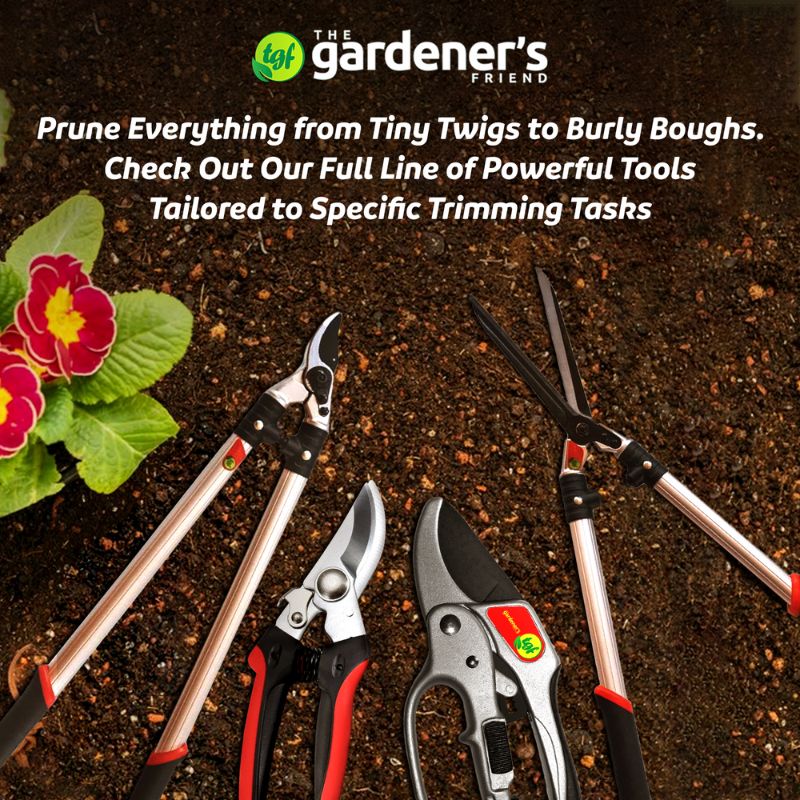Gardens can quickly become out of shape. Leaves fall, bushes sprawl, and hedges get shaggy before you know it.
That’s why you need an active maintenance routine, especially for hedges, which is where hedge shears come in.
Think of them as giant, super-precise scissors for your plants. Hedge shears are simple tools with some powerful use cases.
This guide will walk you through almost all popular use cases of hedge shears so that you can get the most out of them.
Let’s get started.
What Exactly Are Hedge Shears?
Picture regular scissors and make them 18 - 24 inches longer with comfortable handles.
When you squeeze hedge shears, they cut through dozens of branches. This means you don't have to snip individual branches and can tackle a bunch of them in one go.
Why Use Them? Benefits of Hedge Shears
Before discussing their practical use cases, let's briefly talk about the top benefits they offer.
Save Hours of Work: The biggest benefit is that you can trim a 10-foot hedge in minutes.
With this tool, your back won't have to ache like it does with hand clippers.
Crisp Edges = Instant Curb Appeal: You can turn wavy hedges into sharp rectangles with hedge shears in no time.
Healther, Bushier Plants: A light trim signals your shrubs to grow more branches, encouraging healthier, greener growth.
Top Uses of Hedge Shears in Gardening
Let's discuss what hedge shears are capable of, starting from the top use case.
Taming Hedges
As the name suggests, taming hedges is a “Hedge” shears’ superpower. But just having the tool isn't enough; you need to use it right:
While taming hedges, start at the bottom and move up, trimming the sides first. Use a sweeping motion (Smooth and steady).
Keep the bottom broader than the top to let more sunlight in. Also, don’t remove more than ⅓ of your growth in one go. In summer, trim your hedges every 4 - 6 weeks.
Shaping Shrubs
Hedges aren't the only thing these shears tame. You can use them to shape shrubs as well.
Here's how:
Start by lightly shearing the 2 - 3 inch outer growth in summer/spring.
You want to only cut green growth. Avoid cutting woody stems.
Crisp Garden Edges
You can also use them to make your edges neater.
They're perfect for plants like lavender and thyme.
Here's how:
Stand beside your garden bed and hold shears flat against the edge of the plant.
If you see any stems extending out, snip them away.
Seasonal Cleanups
Another use case for hedge shears would be a seasonal refresh of your garden.
When winter ends, use them to shear ornamental grasses. They can get the job done multiple times faster than hand pruners.
You can also trim back dead tops from plants like sedum before new growth starts.
When Not to Use Hedge Shears
While hedge shears are great for many tasks, you can’t use them for everything. Here are some applications where you want to grab a different tool:
Branches Thicker than ½ Inch
Never use hedge shears on branches that are more than ½ inch thick (More than a pencil). Trying to cut anything thicker can bend your blades. For thick branches, grab loppers or a saw.
Precision Pruning
Some plants need precision work. Hedge shears can be too blunt to make exact cuts. Instead, you want to grab hand pruners when accuracy is important.
The rule of thumb for hedge shears? They're ideal for trimming and shaping. They're not suitable for every gardening task, especially the ones that require precise cuts.
You May Also Like: Hedge Trimmer Vs. Pruning Shears (A Detailed Comparison)
Picking a Perfect Pair of Hedge Shears
Not every hedge shear is right for you; here are some considerations for buying a new pair:
Consider Blade Length: Shorter blades (8 - 12 inches) are suitable for more precision work (Although not as good as pruners).
Longer blades (18 - 24 inches) are better for trimming large hedges faster. The right blade length depends on your needs.
Prioritize Comfort: Look for cushioned, non-slip handles and a lightweight design.
Check Build Quality: High carbon steel blades stay sharper for longer. Stainless steel ones tend to last longer as they're more rust-resistant.
Manual Vs. Electric: Manual shears are quieter and lighter; Electric shears are faster for big jobs but can be heavy.
How to Use Hedge Shears Like a Pro
Sharpening
Dull shears are no good; they can damage plant growth. Sharpen them 2 - 3 times a year. You can use a simple hand file or a sharpening stone.
Cleaning and Disinfecting
Clean your shears with a plain cloth after every use and disinfect them with rubbing alcohol or a bleach solution. Spray blades with WD-40 or rub with oil.
Safety
While using hedge shears, or any other gardening tool, protect yourself with gloves and safety glasses. Plus, use a ladder for large hedges.
Frequently Asked Questions
What Can Hedge Shears Be Used For?
Trimming and shaping hedges and shrubs. You can also use them for edging borders and cutting back ornamental grasses. They’re ideal for soft growth under ½ inch.
When Should You Not Use a Hedge Trimmer?
Avoid cutting thick branches (>½ inch), and for precision work. Use hand pruners where precision and delicacy are important.
What Else Can I Use Hedge Shears For?
Pruning herbs like rosemary, tidying groundcovers, and cutting back dead tops. Hedge shears aren’t for delicate plants and thick branches.
What is the Difference Between Garden Shears and Hedge Shears?
Hedge shears have longer blades, which makes them ideal for bulk trimming. Garden shears are shorter, which makes them good for detailed work like deadheading flowers.
Conclusion
Hedge shears make garden cleanup super convenient and efficient. They let you trim hedges and shrubs quickly and tidy up edges, saving you time and effort.
Just make sure you use them for small branches only. They won’t work well for cutting anything thicker than a pencil (½ inch).
Read More: Electric Pruning Shears (Are They Worth It?)


